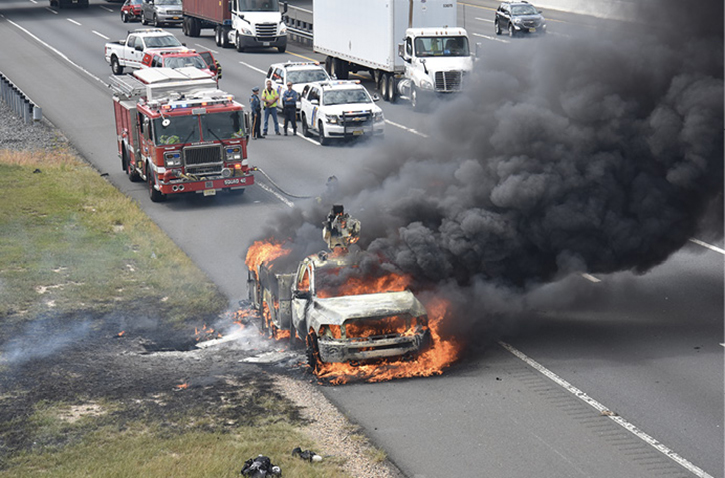
Since vehicle fires are so common and the frequency of injuries at these incidents is relatively low, many firefighters become complacent and treat them as routine or even nuisance calls. Vehicle fires are anything but routine and can quickly escalate to a major incident if we treat them as just an ordinary call for service. A burning vehicle may begin rolling toward your engine company, a hood strut can become an airborne projectile and injure a firefighter, or a distracted motorist may strike the fire apparatus at a highway incident.
According to the National Fire Protection Association, there are an average of 223,300 highway or road vehicle fires per year. The American fire service responds to a vehicle fire every 2.3 minutes.1 Although most firefighter injuries occur while fighting structure fires, 1,100 firefighters are injured annually while fighting vehicle fires.2
RELATED FIREFIGHTER TRAINING
The Officer’s Guide to Preparing for and Commanding Large Vehicle Fires
Vehicle Fires: Is It Time to Change Our Training?
EXPECT THE UNEXPECTED IN VEHICLE FIRES
Highway Operations
Vehicle fires present a myriad of hazards that may be well known but underappreciated. Responding to highway vehicle fires (especially during inclement weather or at night) is one of these hazards. Highway operations are among the most dangerous incidents for firefighters, emergency medical services (EMS) professionals, police, tow truck drivers, and transportation department workers. Our vehicles are struck at an alarming rate by impaired/distracted drivers.
Over the past decade, responder safety while operating on highways has become a priority. Now, most departments’ emergency response procedures to highway incidents dictate using advanced warning techniques, blocking, safe positioning, and high-visibility personal protective equipment (PPE).3 “Move Over” laws and the related public education programs have brought more attention to the dangers. In photo 1, a temporary traffic control zone has been established using several emergency services vehicles as firefighters stretch a hoseline to make an initial attack on this truck fire.

(1) Photos by author unless otherwise noted. (Photo by Brian Johnson.)
In 2016, New Jersey published Version 3 of “Traffic Incident Management Safety (TIMS) Guidelines for Emergency Responders” to establish uniform statewide guidelines for emergency response to limited-access highways and other roadway incidents. All fire service members must follow the best practices for maintaining safe corridors, using a blocking fire apparatus, and using the incident command system (ICS) on all highway incidents—including vehicle fires. Most vehicle fires are designated as minor or intermediate incidents under these guidelines based on the time needed to clear the incident from the roadway.4
We must be proficient in operating on the highway at vehicle fires. Although personnel safety is always a priority, we must mitigate the incident and clear the scene as quickly as possible. Smaller departments with limited resources need to get the apparatus and crew back in service to handle additional calls. Also, opening closed lanes and returning the normal highway flow of traffic help prevent secondary incidents.
Know Your Local Highways
Fire department apparatus operators and company officers must know their local highways and all their nuances in their primary and secondary response areas. Many limited-access highways have designated car, truck, or high-occupancy vehicle lanes. Additionally, there may be flyovers or median cutouts designated for emergency services use. Know where they are, together with mile markers, on/off ramps, and highway sections that may be difficult to access because of construction or roadway configuration. Knowing all aspects of the highways in your response area is crucial in your preincident size-up.
Arrival and Size-Up
Life safety is our first priority at every emergency. Begin considering your size-up while responding to the fire, accounting for potential rescue or civilian injuries based on the dispatch. If the call is dispatched as a motor vehicle crash with a fire, be prepared to go into rescue mode on arrival. If an occupant is trapped in a vehicle that is on fire, consider whether extinguishing the fire before initiating extrication is more beneficial. If the patient is physically entrapped, initiate fire attack immediately and ensure that an apparatus equipped with extrication tools is also responding. If the victim is not trapped but is still in the car, consider immediate rescue or performing simultaneous fire suppression and victim removal. Often, bystanders or police officers will have removed victims prior to fire department arrival. Be prepared to initiate medical treatment for life-threatening injuries if EMS is not on scene or is delayed.
Your arrival scene report should focus on the normal incident priorities of life safety, incident stabilization, and property conservation. Always confirm the incident location, the fire’s extent, and any injuries/entrapment; identify exposures; update scene access/staging instructions for additional units responding; request additional resources, if needed; and establish command.
Call for help early in the incident, especially on a limited-access highway. Other companies may face extended response times or traffic delays. Set up automatic-aid agreements to ensure that enough fire and EMS apparatus will already be responding from the opposite direction on the highway to counter the delays caused by lane closures and rubberneckers.
For fires involving trucks, recreational vehicles (RVs), or other large vehicles, call for extra engines and water tenders as soon as possible (photo 2). Anticipate that these fires will exhaust the water in your onboard booster tank before the fire is fully extinguished.
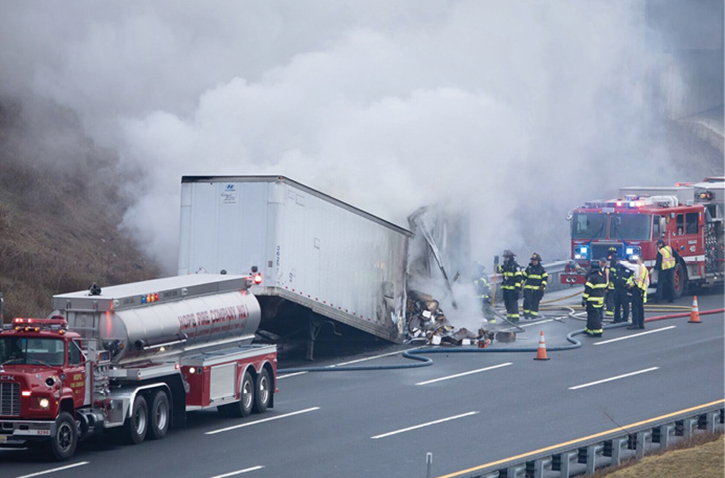
(2) Photo by Dennis Symons.
Many large vehicle fires also require extensive overhaul. In photo 2, note how fire has damaged the structural integrity of the trailer. On a limited-access highway, consider sending an engine to a nearby surface street with hydrants and hand-stretch a supply line to the highway. For fires on elevated roadways, consider lowering a supply hose to a second engine or tanker/tender below on a surface street.
Stage apparatus at vehicle fires uphill and upwind, if possible; quickly deploy wheel chocks under the burning vehicle’s tires. In numerous incidents, burning vehicles have begun to roll downhill, even on very slight grades, after fire department arrival. Neglecting this basic safety measure has resulted in avoidable apparatus damage.
On arrival, perform your size-up, and ensure your scene safety according to Federal Highway Administration’s Traffic Incident Management System (TIMS) guidelines or your local protocol. Choose the safest and most appropriate approach and the proper hoseline to stretch. Vehicle fires encompass an infinite number of scenarios, especially those threatening or spreading to exposures (structures or other vehicles). Use the most appropriate fire attack methods to quickly and effectively mitigate the incident.
The hoseline stretched must provide an adequate fire flow to overcome the high heat release rates of modern vehicle fires. It is recommended that no smaller than a 1½-inch attack line capable of flowing a minimum of 125 gallons per minute (gpm) be stretched. Firefighters should be in full turnout gear (including hoods), wearing their self-contained breathing apparatus (SCBA) and being masked up and on air. Because of the potential dangers of flammable metals and fluids, allow no skin exposure.
In photo 3, firefighters have staged upwind from the incident. Wearing full PPE/SCBA, the nozzle firefighter has stretched a 1¾-inch handline to initiate fire attack. The company officer approaches to chock the wheels on the burning truck.
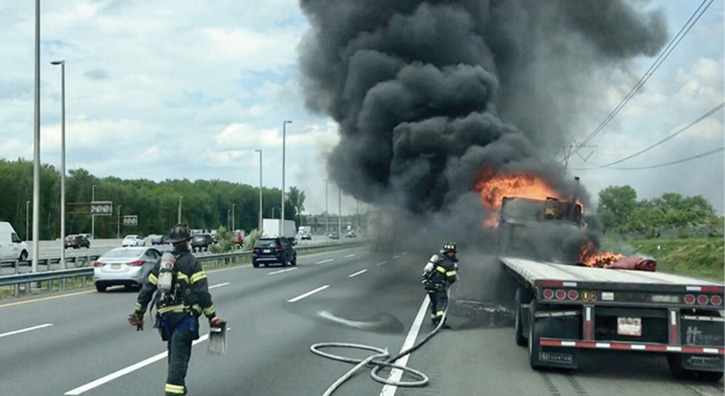
(3)
Vehicle Fire Hazards
Heat and Toxic Fumes
If you are still fighting vehicle fires with booster lines and without SCBA, consider the following information about the heat and toxic gases produced by vehicle fires. Modern vehicles are constructed largely of polyurethane foams (PUFs) and plastics, including most of the interior finish, the headliners, the body parts, the doors, and the windows; the seats, the arm and head rests, and instrument panels are all constructed largely of PUFs. The fenders, spoilers, bumpers, and other exterior parts may now be constructed of reaction-injected polyurethane.5
PUF fires produce very high heat release rates, toxic fumes, and temperatures nearing 1,500°F, as a National Institute of Standards and Technology (NIST) PUF test has shown.6 Once the PUF ignites, the fire rapidly spreads throughout the vehicle and to nearby exposures.7,8 PUF fires “generate highly toxic fumes of oxides of nitrogen and carbon including extremely toxic hydrocarbon compounds, such as hydrogen cyanide.”6 Burning PUF also generates numerous other poisonous, toxic, and carcinogenic compounds.8 Wear your SCBA!
Bumper Pistons and Struts
Vehicles from the 1970s and 1980s (many are still on the road) feature energy-absorbing bumper pistons that if exposed to heat can explode and become projectiles. In a close call, a 1987 Volvo bumper piston exploded; a piece of the piston went through an arriving fire engine’s windshield, injuring the apparatus operator.9 Hood and trunk/hatch struts present the same danger if exposed to fire; they contain compressed gas at 1,500 pounds per square inch (psi).10 In a January 2005, Sacramento, California, incident, a superheated strut under the hood of a car on fire exploded. The one-inch cylinder exited the vehicle and passed through a firefighter’s leg before landing more than 50 feet away.11
Flammable Metals
Flammable metals also pose a risk to firefighters. As we know, water applied to burning magnesium will cause a violent, sometimes explosive, reaction. Magnesium was widely used in Volks-wagen engine blocks and crank cases starting in the 1950s. Modern vehicles now contain numerous magnesium components such as the power train, suspension, chassis, steering wheel armatures, steering column brackets, gear boxes, clutch housings, and oil pans.12 Always anticipate that vehicles contain magnesium components and there is a strong likelihood they will be involved in the fire. Often, you won’t know whether it is a flammable metals fire until you apply water to the vehicle, as shown in the helmet camera image in photo 4.

(4) Photo by Erik Eitel.
Generally, at all vehicle fires, you should initially knock down the fire and attempt to cool the vehicle from a distance. If your hose stream contacts burning flammable metals, you may see a brilliant and powerful reaction that can shower firefighting personnel with burning embers of hot magnesium and other alloys. This is why it is imperative that you wear full turnout gear and have no exposed skin.
You may also see a distinctive and brilliant “white” area burning typically coming from the floor on the driver’s side near the base of the steering column. This is likely magnesium. Use a straight or solid stream to rapidly cool the areas surrounding the burning magnesium. Concentrate on first extinguishing the rest of the fire that is away from the combustible metals. Once the entire area is sufficiently cooled, the burning magnesium will typically self-extinguish. If not, consider using a Class D extinguisher, although this is generally not required to extinguish the small amount of combustible metals that may flare up during fire suppression.
Air Bags
Modern vehicles can contain up to 10 (or more) air bags. There are documented cases of activations and explosion of the various types of air bags and their inflator devices at vehicle fires. Steering wheel and front passenger air bag inflators contain sodium azide. Under normal circumstances, the air bag activates when a small electrical charge ignites sodium azide inside the air bag inflator, which rapidly converts to nitrogen gas.
An air bag fully inflates in 0.03 seconds.13 Sodium azide decomposes and spontaneously ignites at temperatures between 527°F and 626°F.14 We already know that a passenger compartment fire will easily exceed that temperature, so it’s no surprise that an air bag can potentially activate at vehicle fires and injure personnel.
Compressed gas inflator cylinders containing pressurized inert gas control the side curtain and other air bags. Under the extreme heat of a vehicle fire, these compressed gas cylinders will rapidly heat up and activate the air bag, or the cylinder itself may overpressurize and rupture. An air bag inflator cylinder that ruptures in a fire can become a flying projectile. Avoid leaning into the passenger compartment of vehicles on fire to reduce the risk of injury by an air bag or an air bag inflator cylinder explosion.
Alternative Fuels
Modern vehicles run on a variety of fuels including gasoline, ethanol, diesel, compressed natural gas, and electricity stored in battery packs. Each of these poses its own potential challenges to firefighters operating at vehicle fires. Modern “gasoline” vehicles are actually running on a mixture called E10, which is typically 90% gasoline and 10% ethanol. Some vehicles run on “flex fuel” (formerly “E85”), which is a blend of between 51% and 83% ethanol and gasoline.15 If you are fighting a vehicle fire and the vehicle’s ethanol-blended fuel becomes involved, you will need to use an alcohol-resistant (AR) foam solution to effectively suppress the vapors and extinguish the fire.
Standard Class B foam will not be effective on a fire involving an ethanol mixture. You must use alcohol-resistant agents capable of suppressing vapors and extinguishing an ethanol-blended fuel fire. Additionally, flames from burning ethanol are nearly invisible to the naked eye, especially during daylight hours.16
Plastic Fuel Tanks
Firefighters are experiencing an increase in fuel spill fires involving flammable ethanol/gasoline mixtures. Since the late 1980s, more plastics have been used in place of pressed steel for fuel tanks.17 Up to 70% of all fuel tanks produced in North America are made of plastics. Although plastic fuel tanks will retard the rise in fuel temperature from a well-involved vehicle fire, they will soften, sag, and eventually release the fuel onto the ground, potentially creating a running fuel fire18 requiring the use of AR foam (photos 5-6). Alternatively, a dry chemical fire extinguisher may also be effective on such fires. Anticipate fuel tank failures at well-involved vehicle fires, and stage apparatus away from the potential path of flowing fuels.
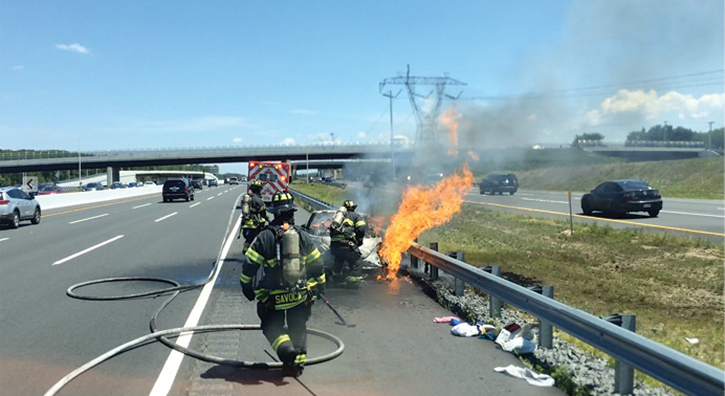
(5)

(6)
Less common, but still dangerous, are fires involving vehicles powered by alternative fuels such as compressed natural gas (CNG), marked by a blue diamond badging (photo 7). Although these vehicles make up only about 0.1% of the total vehicles on the road in the United States, CNG is becoming extremely common on refuse trucks and public transit buses (12-15%). Some light trucks and cars, such as the Honda Civic, the Chevrolet Silverado 2500, and the Ford F250, may also be CNG-powered.19 CNG conversion kits are available for many other passenger cars, trucks, and SUVs.
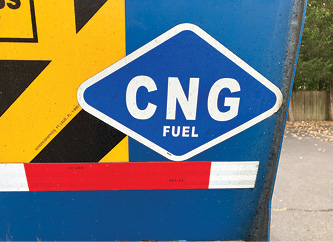
(7)
When a CNG vehicle is on fire, approach with extreme caution. Several well-documented cases of explosions involving CNG vehicles have occurred including in Seattle, Washington (Honda Civic); Indianapolis, Indiana; and Hamilton, New Jersey (refuse trucks).
CNG vehicle fuel tanks are pressurized to 3,600 psi and are equipped with pressure-relief devices (PRDs). If responding to a CNG vehicle fire that does not involve the tanks, proceed with normal firefighting operations. However, if the CNG tanks are involved or the heat of the fire has raised the tank’s temperature and activated the PRD (generally resulting in a loud jet of fire emitting from the PRD), set up a safety perimeter of at least 100 feet around the vehicle, protect exposures, and let the vehicle burn. Either the tanks will rupture or the CNG will vent until the tanks are empty.
If fire is impinging on the CNG tanks and the PRD fails to operate, the pressure in the tanks will rapidly rise; the tanks will fail when the pressure reaches 8,000-9,000 psi. Even if the PRD is operating normally, a CNG cylinder will survive in a fire only for about 20 to 30 minutes.20 In a bystander video of a 2016 trash truck fire in Hamilton, New Jersey, you can clearly see and hear flames and gas venting from a PRD. Despite the fact that the PRD seems to be operating as designed, the cylinder suffers a catastrophic failure and explodes only seconds before firefighters arrive.21
Electric Vehicles
Although electric vehicles (EV) are becoming more common on our roadways, many firefighters have yet to respond to an EV fire. They should become familiar with the extensive emergency response information that EV manufacturers’ Web sites offer.
For example, for its S Model, Tesla recommends a standard approach to fighting fires that doesn’t involve the high-voltage batteries. However, fires involving the batteries can be more challenging. According to Tesla, a fire involving the batteries, which are in the undercarriage, could require up to 3,000 gallons of water applied directly to the batteries to extinguish. Accessing the batteries can be difficult. Agencies have reported that they needed to “tilt” the car to effectively attack the undercarriage battery fires. Even after applying water continuously on the batteries for 90 minutes, these seemingly extinguished fires stubbornly reignited. Tesla’s emergency responder guide reports that batteries can take up to 24 hours to extinguish and can reignite at any time. Tesla battery fires will produce toxic vapors; full PPE/SCBA is a must. Tesla advises fire departments that any time a vehicle’s lithium ion batteries are damaged by collision or fire to ensure that the towing company segregates the vehicle from other vehicles and buildings in a storage yard. Damaged batteries can undergo “thermal runaway” and spontaneously catch fire several hours later. Firefighters should familiarize themselves with the emergency responder guidelines on the various manufacturer Web sites.22
Fighting the Fire
Many of us were taught to fight vehicle fires by attacking from upwind, approaching at a 45° angle, and knocking down the fire from a distance with a straight stream before advancing to the vehicle. Sometimes, scene conditions will alter this approach. Knowing what we know about hood and trunk/hatch struts, even the 45° approach might not be as safe as previously thought. Depending on scene conditions or our response route, we may be unable to stage the apparatus upwind of the fire. If you have to choose, would you rather be uphill or upwind? We have SCBA to protect us from the smoke. On a hill, a burning vehicle may roll back toward the apparatus and a flammable liquids fire will flow downhill. Park the apparatus uphill from the scene. The first-arriving engine officer may face the dilemma of whether to position the apparatus uphill and upwind of a burning vehicle or use it as a barrier to block traffic. These choices may be mutually exclusive. Be ready to improvise or alter your approach as needed on arrival.
Many engine companies use front bumper attack lines. As the first-due engine, attack the fire and stage the apparatus to block oncoming traffic. With what we know about the potential for flying projectiles, we need to provide also an adequate buffer zone between the apparatus and the fire. If you are using a front bumper attack line, ensure that you are stretching an adequate length of hose or can quickly shut down the line, add a length, and resume operations with minimal interruption.
If you begin with a standard fire attack and the fuel tank fails, creating a running/flowing flammable liquids fire, you must quickly switch to a foam operation. At an EV fire involving the batteries, call for additional engines and tankers/tenders. Other large vehicles like tractor trailers and RVs will also necessitate calling extra companies with more water, especially if you’re working on a highway and have no access to fire hydrants. When fighting fires in over-the-road trucks, you must determine what cargo it is hauling (flammable liquids? hazardous materials?) as soon as possible; this could also dramatically alter your approach.
How often have you responded to an engine compartment fire and were unable to get the hood open? This simple task can humble even the most seasoned firefighter. First, “try before you pry.” Try the hood release from inside the car if it’s intact.
If the driver’s compartment is involved in fire or the hood release is inoperable because of fire damage, you’ll need an alternate approach. Initially, to knock down the fire, try striking the corner of the hood on the latch side (vs. the hinge side) with the halligan pike and drive the pike into the hood. Then push up on the halligan, bending up the corner of the hood so you can access the engine compartment for fire suppression (photos 8-9). Use the back of a flathead ax to crease the hood next to where it was spiked with the halligan to make this technique easier. If available, consider using a hydraulic spreader to spread or “tent” the edge of the hood just above the front suspension to access the engine compartment.

(8)
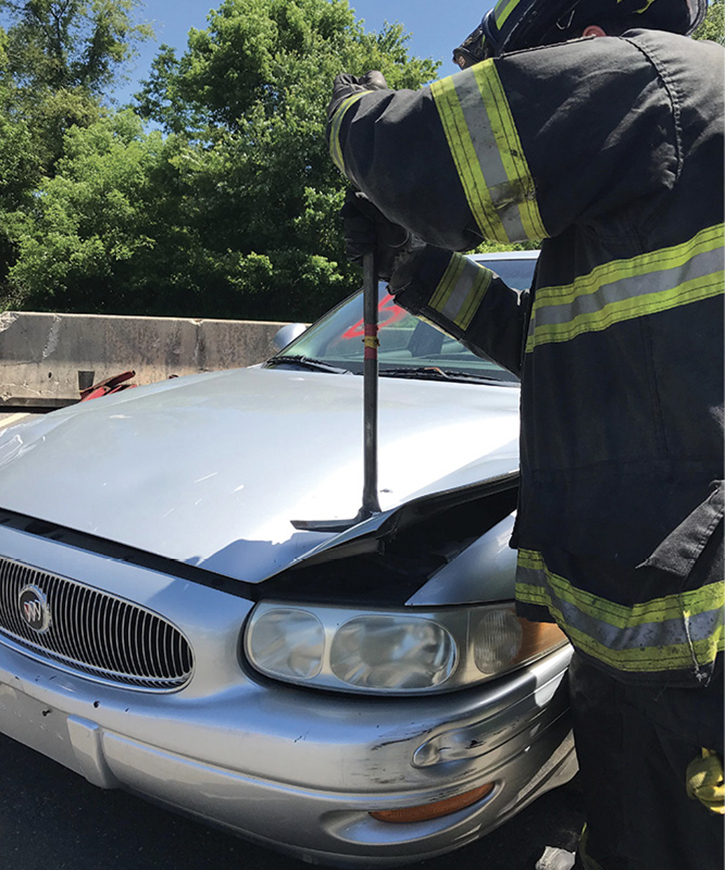
(9)
Another common method for opening the hood is to use the rotary saw to cut a “V” around the hood latch (photo 10) or to make a horizontal cut across the entire hood (photo 11). The horizontal cut is beneficial if you’re unsure of whether it’s a standard opening hood (latch at front, hinges near windshield) or a reverse opening hood (with the hinges near the grille), which may be found on Saabs, Corvettes, and other cars. You can use a reciprocating saw to cut the hood latch or the hinges.
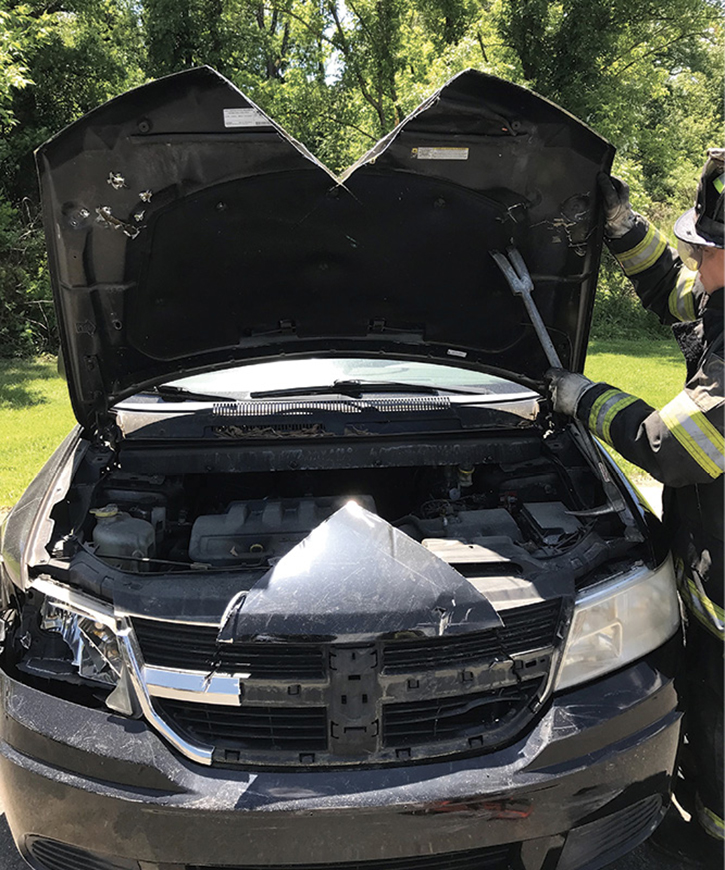
(10)
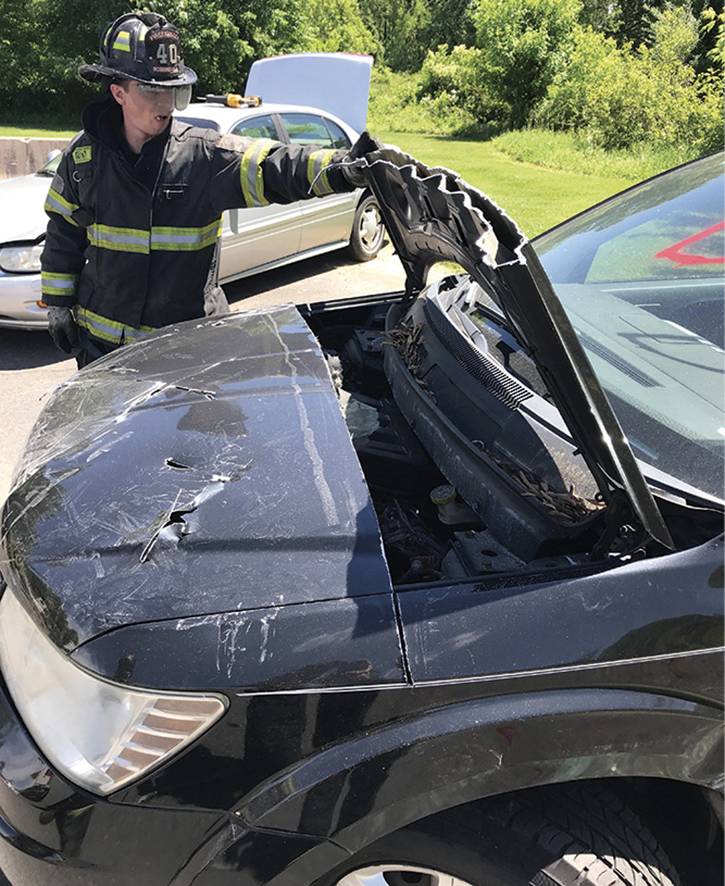
(11)
Another method that I’ve had limited success with, but is still an option, is to remove or crush the grille and attempt to use the fork end of the halligan to wrap and twist the hood release cable. Use caution if using a saw on an electric vehicle hood since a cut too deep into the hood may damage the electrical components. Ultimately, getting the hood open might require a bit of improvisation, especially if your engine doesn’t carry a saw or hydraulic tools.
Vehicle fires are among our most common incidents. Generally, they are mitigated without negative consequences and have a low rate of firefighter injury compared to structural fires. This has lulled many of us to be complacent and to take these incidents for granted. Firefighters must minimize their risks of being struck while working on these incident scenes, stretch appropriate attack lines, chock the wheels of burning vehicles, wear full PPE with SCBA, and appreciate the many associated dangers. Remember, it’s NOT just another vehicle fire!
References
1. “U.S. Vehicle Fire Problem by Type of Vehicle 2006-2010 Annual Averages.” Marty Ahrens, National Fire Protection Association, January 2013. https://bit.ly/2X0KRmq.
2. “Patterns of Firefighter Fireground Injuries.” Richard Campbell, National Fire Protection Association, December 2016. https://bit.ly/3g8ixGf.
3. “Resources.” Emergency Responder Safety Institute.https://bit.ly/3g8ixGf.
4. “Traffic Incident Management Safety Guidelines for Emergency Responders Version 3.” State of New Jersey Office of the Attorney General, Department of Law and Public Safety, August 1, 2016. file:///C:/Users/robertm/Downloads/Statewide%20Guidelines%20Ver%203%20Final%20with%20OAG%20Cover%20Letter.pdf.
5. “Polyurethane for the Automotive Industry.” American Chemistry Council. https://bit.ly/2EpM0O0.
6. “Fire Hazards of Polyurethane Foam.” Klausbruckner and Associates, November 2014. https://bit.ly/33164Aj.
7 “Flame spread and smoke temperature of full-scale fire test of car fire.” Dayan Li, et al. Case Studies in Thermal Engineering. Volume 10, September 2017. https://bit.ly/306Tq17.
8. “The fire toxicity of polyurethane foams.” Sean McKenna and Terence Hull. Fire Science Reviews, April 21, 2016. https://bit.ly/2CJei5J.
9. “Flying Bumper Causes Injury.”Firefighter Close Calls, October 17, 2009. https://bit.ly/3jNG2qn.
10. “Lift Supports.” AMS Automotive. https://bit.ly/2OXJD72.
11. “NY-FF LODD, Strut Expl, FDNY & Drills Update.” Firefighter Close Calls, February 8, 2005. https://bit.ly/39BDffo.
12. “Magnesium Car Parts: A Far Reach for Manufacturers? Part 1.” Gary Kardys, Engineering 360, November 25, 2017. https://bit.ly/3f3qwTF.
13. “How do air bags work?” Joseph F. Merola, Scientific American. https://bit.ly/3064uvj.
14. “Sodium Azide Fact Sheet.” Northeastern University Office of Environmental Health and Safety, July 2010. https://bit.ly/2BDOqYk.
15. “Ethanol.” Exxon/Mobil Fuels. https://bit.ly/2P4nDHu.
16. “Firefighting Foam Principles Instructor Manual, Module 6.” TransCaer.com. https://bit.ly/3jK3qVz.
17. “Polymer Composite Gasoline Tanks.” Lucio Boccacci et al. University of Oklahoma, April 30, 2004. https://bit.ly/2X1ndGB.
18. “Steel vs. plastics: The competition for light-vehicle fuel tanks.” Peter J. Alvarado, The Journal of The Minerals, Metals & Materials Society, July 1996. https://bit.ly/39vLpG2.
19. “Vehicles: See the wide range of vehicles that run on CNG.” CNG Now. https://bit.ly/30RyOZU.
20. “First Responder Guide: CNG and LNG Vehicle Fuel Systems.” Agility Fuel Solutions, July 2017. https://bit.ly/2DcuEUh.
21. Youtube. https://bit.ly/3gdugDu.
22. “2016+ Model S Emergency Response Guide.” Tesla, https://bit.ly/2X4bc2X.
Steven B. Schnaudt is a 28-year veteran of the fire service and a captain with the Robbinsville Township (NJ) Fire Department. He has a bachelor of science degree from Trenton State College and is a New Jersey Level 2 fire instructor and a nationally registered paramedic.

